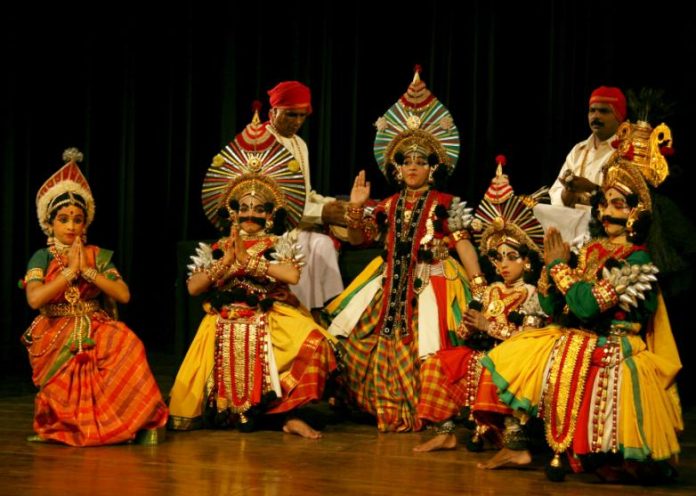In the last segment, we got acquainted with the culture, geography and polity of the state KARNATAKA. If you haven’t read that already, click here – Know your State ‘Karnataka’ – Part 1. The state has an enthralling history, environment, economy, etc. So, let’s explore all these facets in the following article.
Do you know where the headquarters of ISRO located? Which Indian queen from Karnataka revolted against the British’s Doctrine of Lapse? Which state is home to the tallest monolith statue in the world?
So, let’s begin with the History of Karnataka-
Table of Contents
HISTORY Karnataka General Knowledge Notes
Karnataka, lying in the southern part of India has been under the rule of several dynasties that have shaped its history. It has been invaded by a number of rulers at different points of time in history. The history of Karnataka can be traced back to the prehistoric days.
Pre-Historic and Early History
- The pre-historic culture of Karnataka was very different from that of the northern part of India. The hand-axe culture was prevalent in Karnataka. This culture was similar to that of Africa.
- The use of iron was known to the inhabitants of Karnataka even before 1200 B.C. This was far earlier than the time when the inhabitants of North India came to know about the use of iron.
- Some parts of Karnataka were under the rule of Nanda and Maurya Empire of North India during the 3rd and 4th centuries. After the fall of the Mauryan Empire, the Satavahana Dynasty came into power. Prakrit was their administrative language. It ruled over Karnataka for almost 300 years.
- After the weakening of Satavahana Dynasty, Pallavas of Kanchi resulted in becoming the political power for a brief period of time.
- The domination of the Pallavas was brought to an end by indigenous dynasties, the Kadambas of Banavasi and the Gangas of Kolar. The ascent of the Kadamba dynasty and the Western Ganga Dynasty marked the starting point of Karnataka becoming an independent political entity.
MEDIEVAL HISTORY Karnataka General Knowledge Notes
- Kadamba Dynasty (325 AD – 540 AD) – The Kadambas are regarded as the earliest royal dynasty of Karnataka. It was founded by Mayurasharma. It ruled over North Karnataka and the Konkan from Banavasi.
- Western Ganga Dynasty (325 AD – 999 AD) – The Ganga Dynasty was referred to as Western Ganga to distinguish them from the Eastern Ganga Dynasty that in later centuries dominated over Kalinga. The dynasty initially ruled from Kolar and later moved their capital to Talakad. The Gomateshwara statue in Shravanabelagola, constructed around 983 AD, is the tallest monolith statue in the world and is considered to be the most famous Ganga architecture.
- Badami Chalukya Dynasty (500 AD – 757 AD) – This dynasty was founded by Pulakeshin. The earliest dynasty was known as Badami Chalukyas and they ruled from Vatapi (present-day Badami). They were responsible for changing the political atmosphere in South India, shifting from small kingdoms to large empires. The rise of Rashtrakutas eclipsed the reign of the Badami Chalukyas.
- Rashtrakuta Dynasty (757 AD – 973 AD) – It was founded by Dantivarman or Dantidurga II. According to an Arabic text, Silsilat al-Tawarikh, the Rashtrakutas were regarded as one of the four principal empires of the world.
- Kalyana Chalukya Dynasty (973 AD – 1198 AD) – This dynasty is also known as the Western Chalukya dynasty to differentiate them from the Eastern Chalukya dynasty of Vengi. Their ruler, Someshwara I built his capital at Kalyana (present day Basava Kaluyana in Bidar district).
- Sevuna Dynasty (1198 AD – 1312 AD) – The founder of this dynasty was Dridhaprahara. This dynasty is also known as Seuna or Yadavas of Devagiri as they had their capital at Devagiri (present-day Daulatabad in Maharashtra). The Sevunas were once the feudatories of the Rashtrakutas and then of the Western Chalukyas before they declared independence.
- Hoysala Dynasty (1000 AD – 1346 AD) – This dynasty was founded by a legendary individual called Sala. He became famous for killing a tiger in order to rescue his master and thus the empire was named as Hoysala (meaning to shoot it or to hit it). The Hoysalas initially had their capital at Belur but later shifted to Halebidu. They became famous for their temple architecture. The world-famous Chennakesava Temple at Belur, the Hoysaleswara Temple at Halebidu, and the Kesava Temple at Somanathapura are examples of their sculptural exuberance.
- Vijaynagara Empire (1336 AD – 1565 AD) – This empire was established in 1336 by Harihara I and his brother Bukka Raya I of Sangama Dynasty. Hampi was the capital of the Vijaynagara Empire. This empire was famous for its power and wealth. Carnatic music evolved during this era. Some of the best known remnants of the empire’s architectural prowess can be seen at the Group of Monuments at Hampi, which is UNESCO World Heritage Site. The empire declined after it was defeated in the Battle of Tallikota in 1565 AD by the Deccan Sultanates.
- Bahmani Empire (1347 AD – 1527 AD) – The Bahmani Empire is also known as Bahmanid Empire or Bahmani Sultanate. It was the first Islamic Kingdom in Southern India. It was established by Turkic or Brahmin convert Ala-ud-Din Hassan Bahman Shah. The empire collapsed after the last remnant of the Bahmani Sultanate was defeated by Krishnadevraya of the Vijaynagar Empire.
- Bijapur Sultanate (1490 AD – 1686 AD) – The Adilshahi was a Shia Muslim Dynasty that was founded by Yusuf Adil Shah and the dynasty ruled over the Sultanate of Bijapur. The Gol Gumbaz in Bijapur is the most famous monument built during their reign. The Bijapur Sultanate was conquered by Emperor Aurangzeb and it was absorbed into the Mughal Empire in 1686 AD.
MODERN HISTORY Karnataka General Knowledge Notes
- Nayakas of Keladi, also known as Nayaks of Bednore and Kings of Ikkeri, initially ruled as a vassal of the Vijaynagar Empire. In 1763 they were defeated by Hyder Ali and were absorbed into the Kingdom of Mysore.
- The Kingdom of Mysore was initially a vassal state of the Vijaynagara Empire. With the decline of the Vijaynagara Empire, the Kingdom gained independence. They shifted their capital from Mysore to Srirangapattana. In 1687 AD, the Wodeyars bought the city of Bangalore from Mughal by paying three lakh rupees. The Wodeyar Kingdom was overtaken by Hyder Ali by 1761 AD.
- Hyder Ali ruled over the kingdom of Mysore from Srirangapattana. His son Tipu Sultan came to power after him. Tipu Sultan repelled the attack from British many times. Finally, he was defeated due to the united efforts of British, Maratha and Hyderabad Nijamas and was killed on the battle field in 1799 AD. Due to his bravery in the battle field, Tipu Sultan is known as the Tiger of Mysore.
- After the death of Tipu Sultan, major portions of the Mysore Kingdom were annexed by the British and Mysore was transformed into a princely state. The Wodeyars were reinstated as the rulers of the princely state and they ruled till 1831 AD, after which British once again took over the empire.
- After India’s independence, the states were reorganised based on linguistic and other criteria. The Kannad speaking population came together to form the present-day Karnataka under the name of Mysore. It was ruled by the former Maharaja of Mysore as its governor till 1975. Mysore state was renamed Karnataka in 1973.
The rapid urbanization and mining activities in the state have come at a huge cost for Karnataka. The state’s environmental condition is deteriorating at a catastrophic rate due to incessant workforce migration; still it has ample of natural resources and wildlife.
ENVIRONMENT Karnataka General Knowledge Notes
Flora and Fauna of Karnataka are representatives of the rich biodiversity in the state. Wildlife in Karnataka is preserved in the protected areas of the state like National Parks, Wildlife Sanctuaries and Bird Sanctuaries. There are 5 National Parks and 30 Wildlife Sanctuaries.
- The recorded forest of Karnataka encloses an area of about 43,356.74 sq.km. It covers about 22.61 percent of the total geographical area of the state.
- In the forests of Karnataka, there are about 25 percent of elephants and about 20 percent of tigers.
- Important National Parks and Wildlife Sanctuaries
- Bandipur National Park – This Park was established in 1974 as a tiger reserve under Project Tiger. Karnataka is the state with the second highest tiger population in India. The park was once a private hunting reserve for the Maharaja of the Kingdom of Mysore.
- Bannerghatta National Park – The Park, near Bangalore, Karnataka, was founded in 1970 and declared as a national park in 1974. In 2002 a portion of the park, became a biological reserve, the Bannerghatta Biological Park.
- Anshi National Park – Anshi National Park or Anshi Tiger Reserve is a wildlife protected reserve forest area declared by the government of India. It was recently renamed as Kali Tiger Reserve. It lies in the Uttara Kannada (North Kanara) district of the state.
- Kudremukh National Park – It is a mountain range and name of a peak located in Chikkamagaluru district, in Karnataka. It is also the name of a small hill station cum mining town situated near the mountain, about 20 Km from Kalasa. The name Kudremukh literally means “Horse-face” (Kannada) and refers to a particular picturesque view of a side of the mountain that resembles a horse’s face.
- Nagarhole National Park – This national park located in Kodagu district and Mysore district in Karnataka, India. It is one of India’s premier tiger reserves along with the adjoining Bandipur Tiger Reserve and Wayanad Wildlife Sanctuary.
- Dandeli Wildlife Sanctuary – This sanctuary is located in Uttara Kannada district of Karnataka state. The sanctuary covers an area of 866.41 km2. Along with neighboring Anshi National Park, the sanctuary was declared part of the Anshi Dandeli Tiger Reserve in 2006.
- Ghataprabha Bird Sanctuary – It is located in Gokak taluk of Belgaum district in Karnataka. The sanctuary is located in an area of 29.78 sq.km and its boundaries enclose a stretch of about 28 km of the Ghataprabha River. The sanctuary is known for its migratory birds such as the demoiselle crane, European white stork, etc.
- Shettihali Wildlife Sanctuary – It is one of the famous wildlife sanctuaries of Karnataka which is situated in the Shimoga district. The sanctuary covers an area of 395.6 sq.km. It was declared as a wildlife sanctuary on 23rd November 1974.
- Major Dams
- Krishna Raja Sagar (KSR) Dam – KRS is built across the Kaveri River in Mysore and is one of the famous dams in Karnataka. It was constructed by Sir M. Visveswaraya in 1924.
- Tungabhadra Dam – This dam is considered as the biggest dam in Karnataka. This multi-purpose dam is built across Tungabhadra River in Hospet.
- Vani Vilasa Sagara – It is the oldest dam in Karnataka and is situated in Chitradurga and built across the River Vedavathi during the pre-independence age.
- Supa Dam – Supa Dam in North Karnataka is constructed across Kali River.
- Almatti Dam – Almatti Dam was built as a part of the hydroelectric project and Upper Krishna Irrigation Project. It is built across Krishna River in North Karnataka.
- Hemavati Dam – Hemavati Dam in Hassan was constructed in 1979 and is built across over Hemavati River, a tributary of River Kaveri.
Karnataka is one of the most progressive and industrialized states in the country and is a leading state in driving India’s economic growth. So, let’s get on to the next aspect –
ECONOMY Karnataka General Knowledge Notes
Karnataka is rich in natural resources and is known for its salubrious climate. The state’s pre-eminent position on the industrial and business map of India is based on several factors.
- The GDP rank of the state is 4th with Rs. 15.35 Lakh crore.
- The GDP per capita rank is 7th with Rs.210, 887.
- GDP by sector –
Agriculture – 10%
Industry – 26%
Services – 64%
- Karnataka accounts for 59% of total coffee production and 47% of ragi production.
- The state accounts for 85% of raw silk produced in the country.
- Karnataka is the manufacturing hub for some of the largest public sector industries in India, including Hindustan Aeronautics Limited, National Aerospace Laboratories, Bharat Heavy Electricals Limited, Bharat Earth Movers Limited and HMT (formerly Hindustan Machine Tools), which are based in Bangalore.
- Many of India’s premier science and technology research centres, such as Indian Space Research Organization (ISRO), Central Power Research Institute, Bharat Electronics Limited and the Central Food Technological Research Institute, are also headquartered in Karnataka.
- Seven of India’s banks, Canara Bank, Syndicate Bank, Corporation Bank, Vijaya Bank, Karnataka Bank, ING Vysya Bank and the State Bank of Mysore originated in this state.
- Karnataka is the first state which came out with an aerospace policy in the country. Karnataka Aerospace Policy has identified an investment potential of US$ 12.5 billion in this sector during 2013-23 and plans to develop aerospace clusters in different regions of the state.
- The state is India’s largest software exporter, with electronics and computer software export reaching US$ 77.9 billion in 2018-19 and US$ 42.5 million during 2019-20.
EDUCATION Karnataka General Knowledge Notes
The state of Karnataka in India has institutions like the Indian Institute of Science (IISc), Indian Institute of Technology (IIT) Dharwad, Institute of Management (IIM), the National Institute of Technology Karnataka (NITK), Indian Institute of Information Technology, Dharwad IIIT, Visvesvaraya Technological University VTU and the National Law School of India University. In addition, a Visvesvaraya Institute of Advanced Technology (VIAT) is being constructed in Muddenahalli.
As per 2011 census, Karnataka has a literacy rate of 75.36% with 82.47% of males and 68.08% of females being literate.
SPORTS Karnataka General Knowledge Notes
Now, coming to sports, one of the most famous sports in Karnataka is Cricket. The state cricket team has won the Ranji Trophy seven times, second only to Mumbai in terms of success.
- Karnataka’s smallest district, Kodagu, is a major contributor to Indian field Hockey, producing numerous players who have represented India at the International level.
- Born in Bangalore on June 10, 1955, he is, in recent times, known as the father of the famous Bollywood and Hollywood actress, Deepika Padukone. However, Prakash Padukone has many badminton titles in his kitty. The Indian Government awarded him the Padma Shri (1982) and Arjuna Award (1972).
- Anil Radhakrishnan Kumble is first known as a humble being and then a master of spin in Karnataka. He was born on 17 October 1970 and has served as the captain of the Indian cricket team. He had a unique ability to make the ball bounce with amazing speed and modifications, thus earning the name ‘JUMBO’.
Some of the Interesting Facts about Karnataka –
- Karnataka Khadi Gramodyog Samyukta Sangha (KKGSS) is the only unit in India that has the allowance and authorisation of manufacturing and supply of the Indian Flag. It is situated in Bengeri in Hubli and was set up in the year 1957.
- Rava Idli is a popular variant of the Idli which was accidentally produced during the time of World War II due to the scarcity of rice. Instead of rice, then Semolina (durum wheat) was used, and a delicious food item was created, which has been cherished through the decades.
- Karnataka was one of the first states to achieve a setup of a single commercial radio station. In the year 2001, Radio City 91.1 FM was first heard in the city of Bangalore.
- A Plunge Waterfall is one that drops vertically without a connection with the rocks on its way down. The Gersoppa Falls, known as the “Jog Falls” ranks as the second highest plunge waterfall in India.
Karnataka has been home to some very interesting historical figures, discoveries and inventions and that’s what makes it versatile and exuberant. Hope this article helps in your competitive exams such as CDS, Civil Services, SSC CGL, etc. In the next blog, we would be discussing some interesting facts and trivia about the state of Kerala. Click here for Know your State – ‘Kerala’.
If you wish to read about South Indian states, you can click on the links given below:
Know your State ‘Andra Pradesh’
Know your State ‘Tamil Nadu’
Know your State ‘Telangana’




